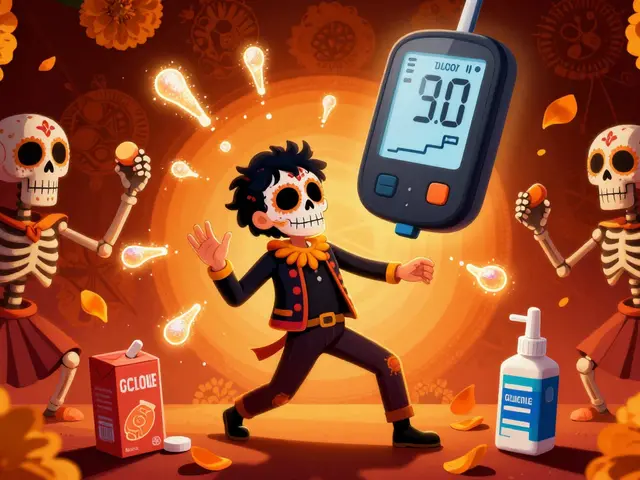Understanding Epigastric Pain and Food Allergies
As someone who has experienced epigastric pain and food allergies, I know how challenging it can be to identify and manage triggers. This article will help you understand the connection between epigastric pain and food allergies, and provide some useful tips to manage your symptoms. I will share my personal experience and knowledge, hoping it will help you navigate this complex issue.
What is Epigastric Pain?
Epigastric pain refers to a discomfort or pain in the upper abdomen, typically felt in the area right below the ribcage. It can range from a mild discomfort to a severe, sharp pain, and it can be triggered by various factors, including certain foods, stress, or underlying medical conditions. In some cases, epigastric pain may be associated with food allergies, which can make it even more challenging to manage.
Common Food Allergens Linked to Epigastric Pain
Food allergies occur when our immune system reacts to a specific food protein, treating it as a foreign invader. This reaction can cause various symptoms, including epigastric pain. Some common food allergens that may trigger epigastric pain include:
- Wheat
- Dairy products
- Eggs
- Soy
- Tree nuts
- Peanuts
- Fish and shellfish
However, it's important to remember that every individual's reaction to food allergens may vary, and some people may experience epigastric pain with other food allergens not listed here.
Identifying Your Food Allergy Triggers
Identifying your food allergy triggers is essential for managing your symptoms and preventing epigastric pain. Here are some steps you can take to identify your triggers:
- Keep a food diary: Write down everything you eat and drink, as well as any symptoms you experience after consuming the food. This can help you identify patterns and potential triggers.
- Elimination diet: Eliminate common food allergens from your diet one at a time, and monitor your symptoms. If your symptoms improve after eliminating a specific food, it may be a trigger for your epigastric pain.
- Consult a healthcare professional: If you're struggling to identify your triggers, consult a healthcare professional, such as a doctor or a registered dietitian. They can help guide you through the process and may recommend allergy testing.
Managing Epigastric Pain and Food Allergies
Once you've identified your food allergy triggers, the next step is to manage your symptoms and prevent epigastric pain. Here are some tips to help you manage your food allergies and reduce your risk of experiencing epigastric pain:
- Avoid your triggers: The most effective way to prevent epigastric pain caused by food allergies is to avoid the foods that trigger your symptoms. This may require careful label reading and asking about ingredients when dining out.
- Plan your meals: Planning your meals in advance can help ensure you're eating a balanced diet that doesn't contain your food allergens. This can also make it easier to prepare meals and snacks when you're busy or on-the-go.
- Seek professional guidance: A registered dietitian can help you develop a meal plan that meets your nutritional needs while avoiding your food allergens.
- Carry emergency medication: If you have a severe food allergy, carrying emergency medication, such as an epinephrine auto-injector, can be a lifesaver in case of accidental exposure to your allergen.
Alternative Treatments for Epigastric Pain
While avoiding your food allergens is the best way to prevent epigastric pain, there are some alternative treatments that may help alleviate your discomfort if you do experience symptoms. These include:
- Over-the-counter antacids: These medications can help neutralize stomach acid and provide temporary relief from epigastric pain.
- Probiotics: Some people find that taking probiotics can help improve digestion and reduce symptoms of epigastric pain.
- Herbal remedies: Certain herbs, such as peppermint, ginger, and chamomile, may help soothe the digestive system and provide relief from epigastric pain.
- Relaxation techniques: Practices like deep breathing, meditation, and yoga can help reduce stress and alleviate epigastric pain.
Remember to consult your healthcare provider before trying any new treatments, as they can help determine the best course of action for your specific situation.
Living with Epigastric Pain and Food Allergies
Living with epigastric pain and food allergies can be challenging, but with the right tools and strategies, you can manage your symptoms and enjoy a healthy, fulfilling life. By identifying your food allergens, avoiding triggers, and seeking support from healthcare professionals, you can take control of your health and minimize the impact of epigastric pain on your daily life.








11 Comments
Prem Mukundan May 7, 2023
Let's cut through the fluff-epigastric pain isn't 'triggered' by food allergies, it's a red flag for systemic immune dysregulation. You're talking about IgE-mediated responses like it's a grocery list, but the real issue is gut permeability compounded by chronic low-grade inflammation. If you're not testing for zonulin or doing a comprehensive stool analysis, you're just guessing. Stop eating 'trigger foods' and start fixing your microbiome.
Kelly McDonald May 8, 2023
Y’all are overcomplicating this so hard 😭 I’ve been there-burning sensation under my ribs after a slice of pizza? Yeah. Cut out dairy and wheat for 3 weeks. Boom. Gone. No labs, no jargon, just listening to your body. You don’t need a PhD to know what’s hurting you. Sometimes the simplest fix is the real one. 💪
Mohd Haroon May 10, 2023
It is imperative to underscore that the conflation of food intolerance with true immunoglobulin-mediated allergy constitutes a profound epistemological error in contemporary nutritional discourse. The pathophysiological mechanisms underlying epigastric distress are neither homogenous nor trivial, and their reduction to dietary elimination protocols risks the institutionalization of pseudoscientific heuristics in clinical practice. One must invoke the principle of Occam’s razor with circumspection.
andrew garcia May 10, 2023
I get what you're saying, Prem. But also... maybe some folks just need to try cutting out dairy before they get a $500 stool test? 😊 I had pain for years, tried everything. Then I stopped eating cheese. 3 days later, I felt like a new person. Not magic. Just biology. Thanks for sharing your story, OP.
ANTHONY MOORE May 11, 2023
My sister went through this for 5 years. Doctors said 'stress'. Then she did the elimination diet and found out she was allergic to eggs. Not the whites-the yolks. Weird, right? But once she cut them, her pain vanished. I’m telling you, keep a food diary. It’s boring, but it works. And don’t be afraid to try it-your gut will thank you.
Jason Kondrath May 12, 2023
Oh please. Another 'eat clean' influencer post. Epigastric pain is almost always H. pylori or GERD. You're just blaming food because it's easier than admitting you need a proton pump inhibitor and a biopsy. And 'probiotics'? That’s the supplement industry’s version of snake oil. Go get a real doctor, not a wellness blogger.
Jose Lamont May 12, 2023
Man, I feel you. I used to get that sharp pain after every meal. Thought it was stress. Turned out it was soy in everything-soy sauce, salad dressings, even some 'healthy' protein bars. Took me 18 months to figure it out. The diary helped. The support helped more. You’re not alone in this. Keep going.
Ruth Gopen May 14, 2023
I have a friend who had epigastric pain for 7 years, and you know what? It was because she was eating gluten-free bread that had xanthan gum-and that triggered her mast cells. She had to go on a low-histamine diet after eliminating gluten. This isn’t just about dairy and nuts. It’s about hidden additives, mold, cross-contamination, and the fact that your gut is a battlefield. You need a specialist, not a blog post.
Nick Bercel May 15, 2023
Wait-so you’re telling me I don’t need to buy $80 'gut healing' powders? I just... stop eating peanuts? And maybe stop drinking almond milk? Huh. Okay. I’ll try it. Thanks, I guess.
Alex Hughes May 17, 2023
It is worth considering that the notion of food allergies as discrete, isolated triggers may be an oversimplification of a far more complex interaction between environmental antigens, genetic predisposition, and the gut-brain axis, wherein epigastric discomfort may serve as a somatic expression of neuroimmune dysregulation rather than a direct consequence of immunoglobulin E binding to dietary proteins, and thus a holistic approach that integrates psychological, nutritional, and microbiological factors may be more efficacious than a purely elimination-based strategy, which, while useful in some cases, may inadvertently reinforce restrictive eating patterns that exacerbate anxiety and further compromise digestive function.
Hubert vélo May 17, 2023
They don’t want you to know this, but food allergies are a scam invented by Big Pharma to sell you epinephrine pens and $300 allergy tests. The real cause? Glyphosate in your bread. It’s in everything. Even the 'organic' stuff. Your epigastric pain? That’s your body screaming because the government is poisoning your gut with Roundup. Go buy organic sprouted quinoa and drink filtered rainwater. Or keep suffering.